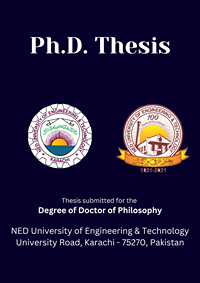Development of a Combined Process for Reactive Printing and Crease Resistance Finish for Cotton Fabric Using Experimental Design Technique (PhD Thesis)
Material type: TextLanguage: English Publication details: Karachi : NED University of Engineering and Technology Department of Textile Engineering, c2012Description: XXII, 160 p. : illSubject(s): DDC classification:
TextLanguage: English Publication details: Karachi : NED University of Engineering and Technology Department of Textile Engineering, c2012Description: XXII, 160 p. : illSubject(s): DDC classification: - 677.21028378242 FAR
| Item type | Current library | Shelving location | Call number | Status | Date due | Barcode |
|---|---|---|---|---|---|---|
 Reference Collection
Reference Collection
|
Government Document Section | Govt Publication Section | 677.21028378242 FAR | Available | 90770 |
v. 1 OF 2.
Abstract :
Modern textile processes have high demand for development of a combined application of crease resistance finishing and reactive printing. A number of experimental and numerical studies on simultaneous fixation of reactive dyeing and crease resistance finishing have become available in recent years. However, some studies have reported on combined application of reactive printing and crease resistance finishing that probably due to contradictory application and fixation conditions of both processes, it is difficult to develop an acceptable combination.
A single step fixation for reactive printing and crease resistance finishing of cotton fabric has been explored in this research work using an experimental design technique (DOE). Initially sets of screening experiments including 2⁶⁻¹ fractional factorial design, 2³ factorial design and 2² 4¹ mixed factorial design have been conducted to efficiently identify the active subset of factors and their interaction. Of the initial six factors namely hue, chroma, drying conditions, concentration of crease resistant, concentration of catalyst and fixation conditions; only the three in italics were found to be significant. Subsequently, optimum conditions of significant factors have also been investigated by 2¹.3³ mixed factorial design with thirteen response variables. The detailed analysis of significant factors including ANOVA, residual analysis, model adequacy checking and regression analysis has been performed. A sample folder has been attached with the thesis compiling all results obtained under various test conditions. An application statistical model has been developed based on these fitted values obtained. The uncertainty analyses for measurements shows that the predicted values are in good agreement with experimental data and are sufficiently accurate.
Evaluation of the combined process in comparison to the two-step combination has been made with respect to K/S value, dry crease recovery angle, tensile and tear strength, pilling, abrasion resistance, fastness to washing, light and rubbing. The analysis of experimental work revealed that wash and rub fastness, pilling and abrasion resistance were as good as those achieved from a conventional reactive printing method. Fabric crease resistance properties were comparable to those obtained from a conventional crease resistance finishing process. More than twenty five percent (25%) enhancement in tensile and tear strength properties of cotton fabric in the combined process was an incidental finding in this research work. However, moderate light fastness of cotton fabric resulted by the combined process.
The combination of the Econtrol* process at 135"C has been verified experimentally to be the best selection for the single step fixation (reactive printing and crease resistance finishing) for the cotton fabric using the pad-dry-print-fix method. The results further show that apart from the influence of individual factors, the said properties of cotton fabric are also reliant on the interaction and curvature effect of the significant factors.
A theoretical reaction mechanism for the combined process with a Monochlorotriazine based reactive dye and modified dimethylol dihydroxy ethylene urea based crease resistant has also been developed validating the premise that the reactive dyes do chemically combine with hydroxyl groups of the cotton fabric as well as a crease resistant that is cross linked with the cotton fabric in the CPF process under certain reaction conditions.
